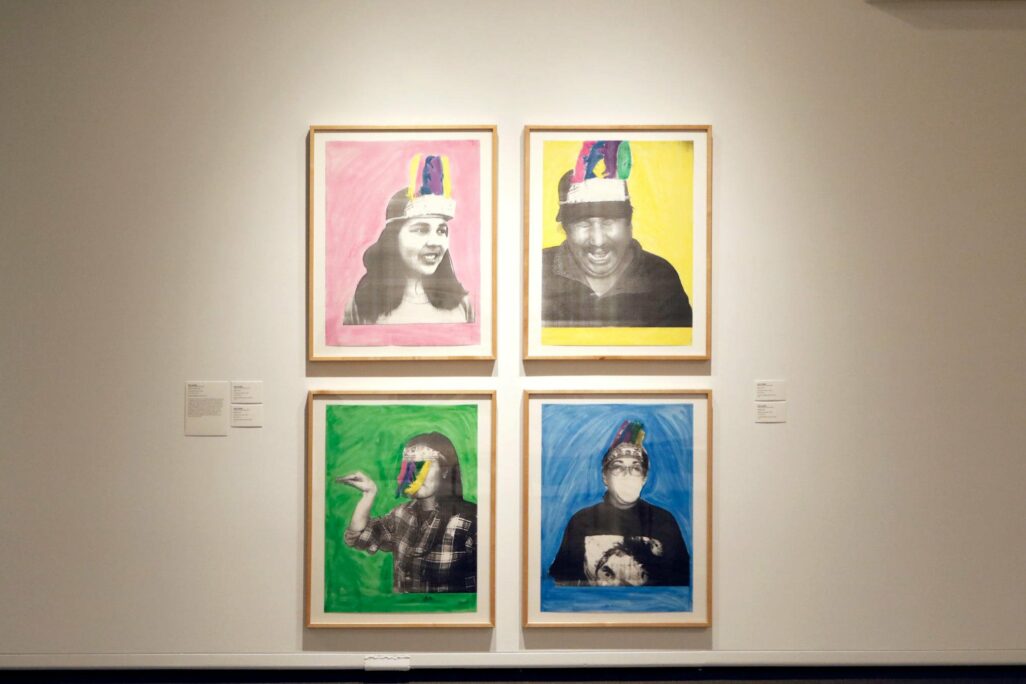I imagined how my dad (Métis, Cree) would have responded to being handed a headdress constructed from chicken feathers and cardboard, and what kind of “Indian pose” he would have felt compelled to do. He’s very confident, that one, and I can imagine the corners of his mouth curling up in a smirk, just like the Grinch did when he thought of a scheme to steal christmas. My dad is a puffed-up chest, muscleman-pose kind of guy, with a toughened poker face, complemented by the vertical scar above his left eye. Next, he says a wise phrase about being spiritually connected to the land, while his tongue is glued to the top of his mouth. He pauses, and we burst into laughter.
Ruth Cuthand created her series Indian Portraits: 20th Century for 20th-century NDNs to feel connected and have a good laugh. Cuthand’s previous work prior to this series reflects topics including cultural genocide, disease, forced assimilation, sexism, and racism. Her generation of artists are the trailblazers for contemporary Indigenous art; they paved a way for the next generation. Artists like Ruth Cuthand and Shelley Niro nudge the youth to think of Indigenous futurism and the way we depict contemporary Indigenous people, both evolved and traditional.
Colonial history and its love for staging and photographing Native people is as funny as it is sad once you adjust your focus and dissect the story behind the colonial photo. I see the discomfort through the statue-like poses and begin to analyze where the eyes are wandering and the lack of muscle movement on their face, other than perhaps an annoyed, furrowed brow which would be provoked by the photographer who staged them with awkward poses and props. The settler lens generalized hundreds of unique people groups and has a direct influence on the way Indigenous people are perceived in society. The typecast traditional Native person is how history has tried to remember us as. Cuthand used comedy, irony, and community to obstruct and question the desire of being “authentic” in relation to our evolved and diverse ways of being, and, further, she pushed for autonomy. In Cuthand’s series, she offers each sitter a retail feather headdress with text on the front that says “Brave Chief.” Family, students, friends, and colleagues were invited to pose with the toy headdress without further instruction, to allow for the photographed series to be social and to multiply the silliness of the stereotypes about Indigenous people. The diversity of Indigenous tropes seen through their serious and not-so-serious poses, mixed with the pop art style and playful colouring, alludes to the purpose, which was to amuse an Indigenous audience with inside jokes and memories of family and cultural connections. Cuthand’s series is critical of the societal and academic pressures of the “authentic” Indian trope and critical of being placed as a relic of the past.
-Holly Aubichon
Holly Aubichon is an emerging artist and art administrator for Sâkêwêwak Artists’ Collective. She identifies as Métis, Cree (Aubichon), Ukrainian, Irish and Scottish (Ogrodnick), born and raised in Regina, SK. Her Indigenous origins come from Green Lake, SK, and Lestock, SK. Aubichon’s practice is laboriously reliant on retracing familial memories and connections. She uses painting as a way to foster personal healing. As an extension of her practice, she has begun a traditional Indigenous tattoo mentorship to acknowledge the memories that bodies hold, support healing and grieving, and participate in the revival of traditional tattoo practices. She graduated from the University of Regina in Spring 2021 with a Bachelor of Fine Arts, minoring in Indigenous Art History. Aubichon is the winner of the 2021 BMO 1st Art! Award, Saskatchewan.

